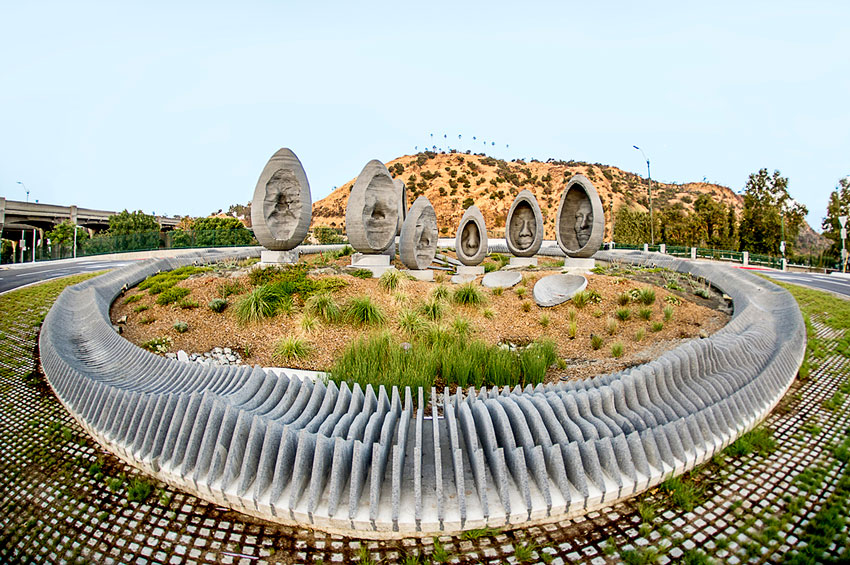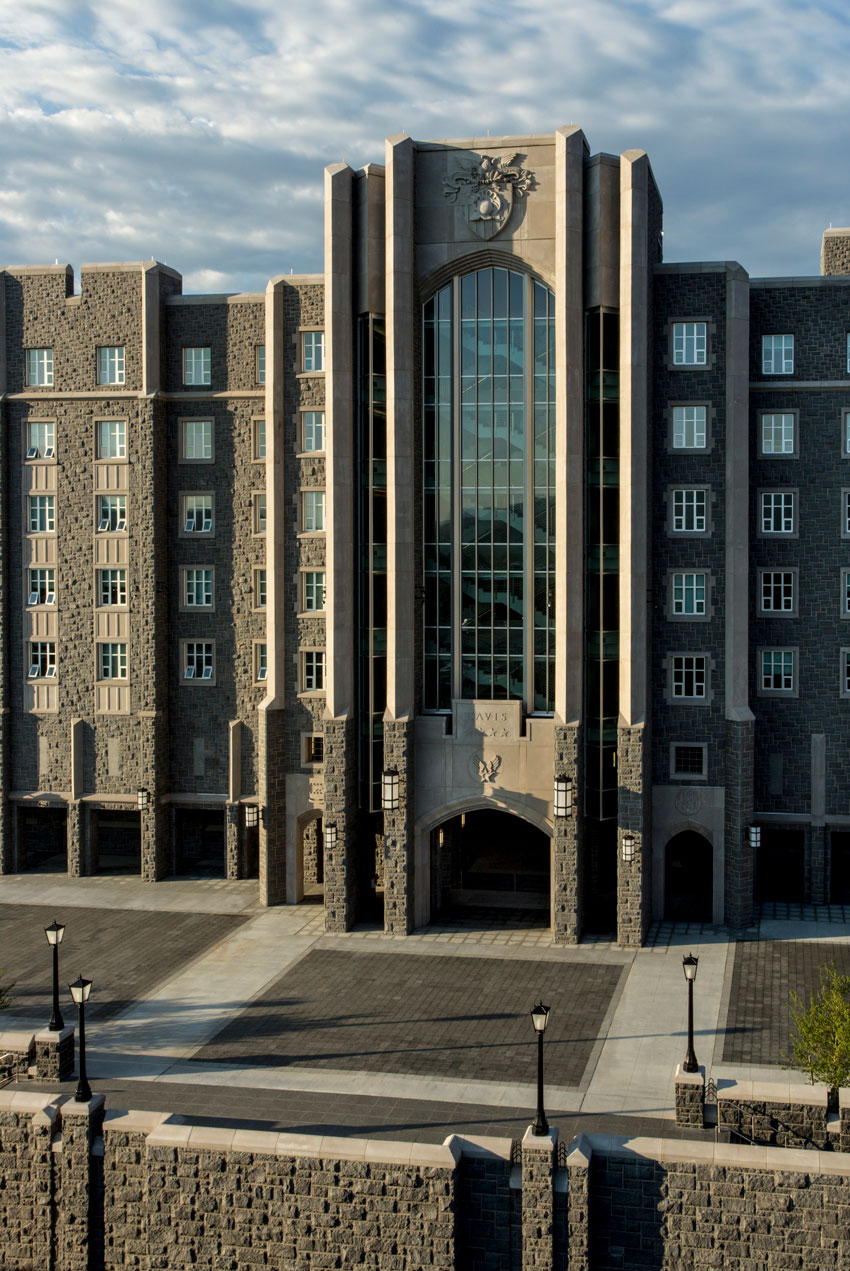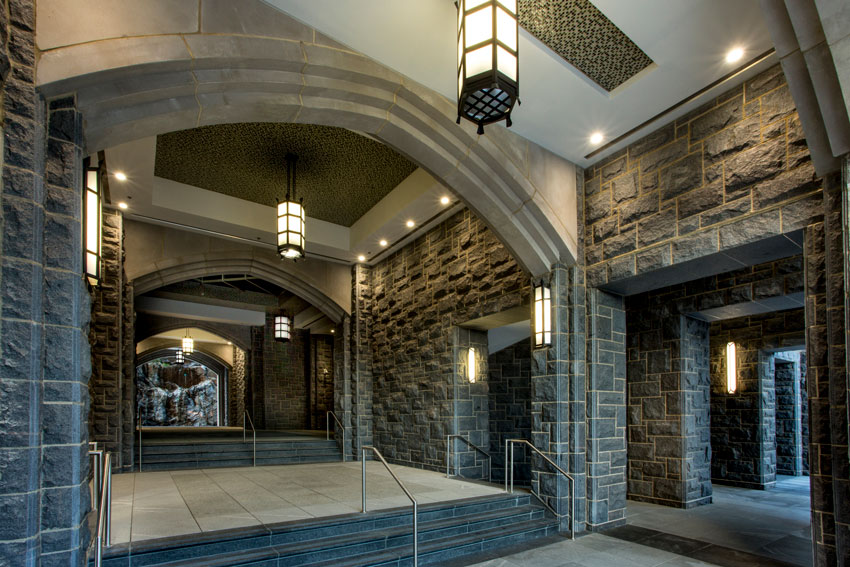Digital Fabrication and Natural Stone
Three-Dimensional Modeling
Riverside Roundabout, Los Angeles
This project is an example of how an artist used new three-dimensional fabrication modeling in a major sculptural installation. The Riverside Roundabout is the first modern roundabout in Los Angeles and will help control negative environmental impacts on the community, with extensive plantings and water storage.
The centerpiece of the roundabout, designed by Greenmeme Art & Design Studio, includes the installation of nine egg-shaped stone sculptures constructed of black granite with a sawn finish from a California quarry. Measuring 8 to 12 feet tall, the sculptures feature the faces of individuals from the community, randomly chosen throughout two years.
The design team took advantage of digital technology to control the fabrication of these sculptures from development through installation. It carefully coordinated the entire process from the artist’s three-dimensional drawings to its final installation. The adaptation of CNC machinery to natural stone fabrication machinery provides both quality control and greater accuracy of the stone’s shaping and final fit and finish.

Photo courtesy of Makena Hunt
Employing three-dimensional modeling and CNC fabrication, the artist and the granite supplier created a monument to sustainability and the community.
A significant amount of coordination between the local public artist Greenmeme and the granite supplier and fabricator ensured the artistic vision came to life. The granite supplier and fabricator used the designer’s electronic files to create the cutting information needed to fabricate the sculptural pieces. Greenmeme provided detailed drawings that required pieces to be numbered and assembled precisely to form the egg sculptures. Each piece was laid out on a slab per the design. The granite supplier selected and cut the slabs with CNC cutting equipment to provide full utilization of the slab, reducing any waste material from the quarried stone. Sculpture pieces were then epoxied together per the design drawings.
The roundabout serves as a stormwater bioretention landscape, with the capacity to capture and treat a 10-year rainfall event (500,000 gallons) off an adjacent bridge and roads. The system also includes a 25,000-gallon cistern supplying a water feature as well as a solar tracking photovoltaic system powering irrigation, lighting, and the artwork. A 100-percent sustainable project, all parts of the granite slabs were used to create the eggs, with the remaining parts of the slab creating a stone border around the roundabout.

Photo: © Amesse Photography
Nearly 200,000 square feet of beautiful, custom-cut, and hand-crafted pieces were used for the exterior, site wall, stair treads, coping, sills, and paving of West Point’s newest cadet barracks.
Construction, Waste Reduction, and Scheduling
West Point, New York
The use of natural stone for the West Point Military Academy is an example of how a project team maximized all of the benefits of natural stone. They met the challenge of tight site conditions on this historic campus as well as managed a shifting schedule. Careful coordination and constant communication with the stone supplier and fabricator was a key to the success of this project.
Since 1802, the U.S. Military Academy at West Point in upstate New York has played a significant role in the instruction of some of the nation’s finest military leaders. With the large numbers of men and women entering West Point, the addition of a new barracks was crucial. The new cadet barracks are named after Benjamin Davis Jr., a former Tuskegee Airman named the first African-American general officer in the U.S. Air Force.
When constructing the new barracks, it was important to West Point to match the existing feel and color of the 200-year-old campus’s gothic revival architecture as well as use a product that will last another 200 years, making granite a natural choice. The architect visited the stone supplier and fabricator’s facilities and local quarry to help envision the project.
Many design teams choose to visit the quarry that may supply the natural stone for their project. A visit to a quarry and to a fabrication facility allows a design team to review the natural stone deposits. Natural stone may have a wide range of color variations and material characteristics. Quarry personnel can provide critical insight on a quarry’s history, equipment operations, and capacity. Touring a fabrication plant allows the design team to evaluate the facility and its capability to collaborate with digital technology. The fabricator can provide information on three-dimensional and physical modeling, and explain its approach to sustainable waste management and installation sequencing.
Nearly 200,000 square feet of beautiful, custom-cut, and hand-crafted granite pieces were used for the exterior, site wall, stair treads, coping, sills, and paving of West Point’s newest cadet barracks. Two types of black granite were selected, and the design team modulated finishes and placement to create a rich palette of materials throughout the site. The stone facade and interiors complement the existing buildings on the 200-year-old campus, and the new buildings are designed to last for the next 200 years.
With a tight deadline, it was essential that the granite supplier and fabricator had complete control over shipping the 200,000 4-inch-thick, split-face pieces of granite from central Minnesota to upstate New York. It’s not typical for split-face applications to be shipped in their finished state to a job site, but the precise installation process utilized on this project made it possible. Each piece was handcrafted and numbered to fit into a specific spot, and once on-site, all of the pieces were easily assembled. This cut down time and on-site work significantly. This process also supported the tight construction conditions, as this project was essentially being built into a hill without room for extra construction material on-site. The barracks were dedicated on May 1, 2017 and began occupancy fall of 2017. The stone supplier and fabricator was able to provide the colors, quality, coordination, and schedule needed for the project.

Photo: © Amesse Photography
Two types of granite were fabricated in multiple finishes to provide variety of textures in each application as well as unify the architectural composition.









